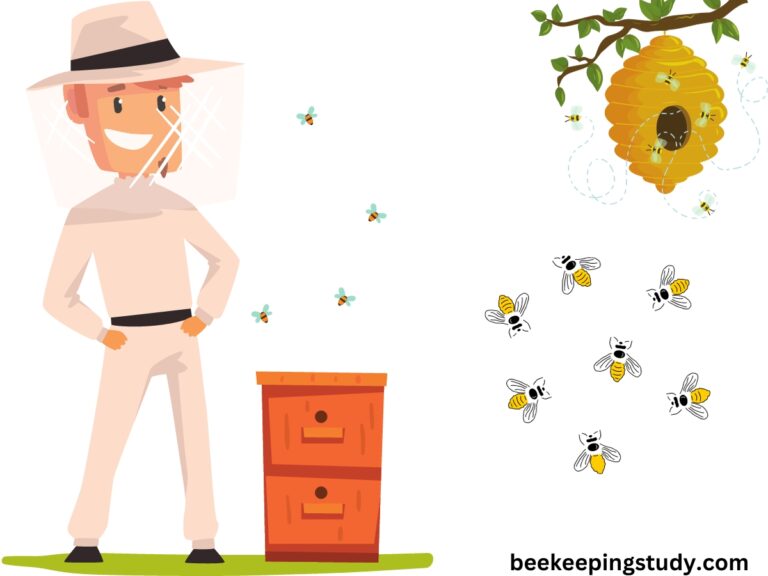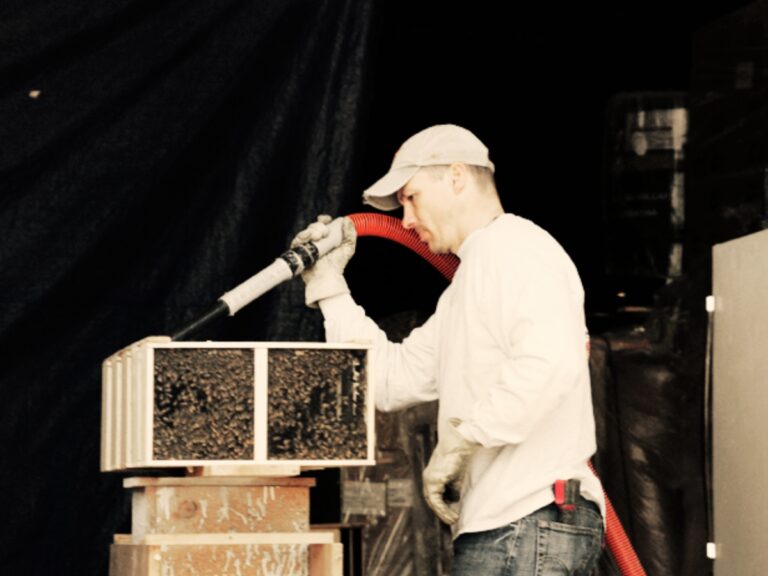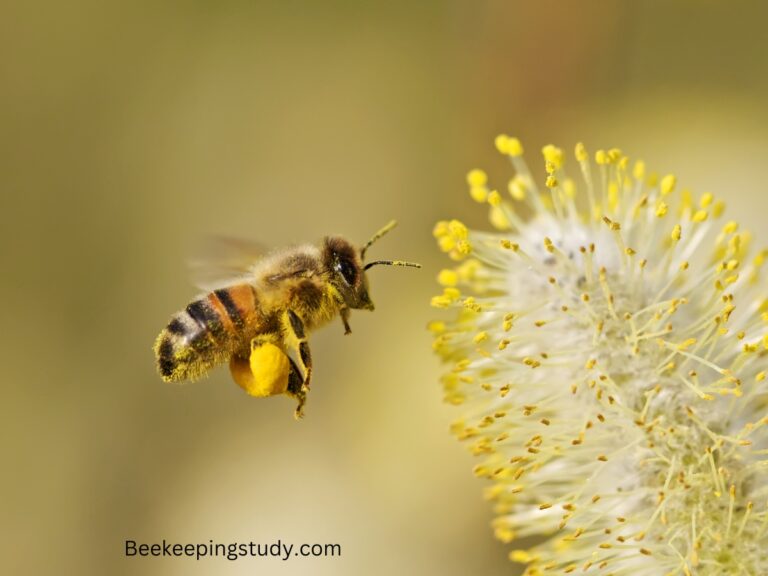This post might be created with help from AI tools and carefully reviewed by a human (Anthor Kumar Das). For more on how we use AI on this site, check out our Editorial Policy.
Moisture Board vs Quilt Box : Which One To Choose For Bees?
Moisture board and quilt box are both used to control moisture inside a beehive. Both are used for slightly different purposes and are constructed differently. You might be asking which one is suitable for your beehives. That’s what we are going to figure out throughout this post.
What Is A Moisture Board?
A moisture board is typically a board made from wood or similar types of materials having moisture absorbents. It contains moisture-absorbing materials like wood shavings, sawdust, and so on.
Moisture board usually goes on top of the hive underneath the outer cover and above the inner cover. It absorbs the moisture from dripping down the hive and controls airflow to the hive.
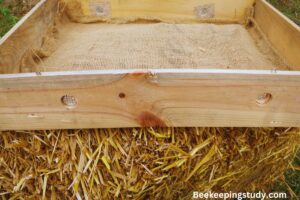
How Does A Moisture Board Work?
The moisture board is mainly used to absorb extra moisture from a hive during winter. Bees generate heat by clustering together, and this can create condensation when warm air meets the cold outer cover. Which can create small water drops dripping into the beehive.
Moisture board absorbs the condensed water and prevents dripping back onto the bees. Also, a moisture board with a ventilation hole controls airflow inside the hive. This helps to regulate moisture levels more effectively.
You can build a beehive moisture board on your own. You can also purchase it from several online or from your beekeeping kit suppliers.
What Is A Quilt Box?
A quilt box serves a similar purpose as a moisture board does with some additional benefits. Unlike moisture board quilt boxes are usually placed inside the beehive right above the brood box. Quilt boxes are more effective in controlling moisture as well as ensuring insulation.
How Does A Quilt Box Keep Bees Warm?
A quilt box is almost similar to a brood box. Instead of frames, it contains absorbing materials like sawdust, wood shavings, straw, foam, etc. The quilt box absorbs extra moisture from the brood box and other boxes above it.
It also provides additional insulation to the hive. In most cases, It has a ventilation hole to control airflow through the hive. A quilt box can hold more amount of moisture than a moisture board.
You can get more information about the quilt box here.
Moisture Board vs Quilt Box Pros And Cons
As far as we know both moisture board and quilt box serve almost similar purposes. But both of them also have some additional advantages and constraints too. Let’s discuss them.
Beehive moisture board Pros
- The moisture board is specifically created to absorb excess moisture during winter months.
- It prevents the condensed moisture at the top of the hive from dripping back onto bees.
- Sawdust or wood shavings used on the moisture board can provide some kind of insulation to the bees. It locks the heat generated by the bees inside the hive.
- Having a ventilation hole moisture board also ensures balanced airflow inside the hive. It is mostly useful during the season when the moisture level fluctuates.
- It is really easy to install in a beehive without the need for much guidance.
Beehive Moisture Board Cons
- It might not be effective to provide good insulation to the brood boxes.
- There is a chance bees can seal the insulation hole with propolis. This will reduce the effectiveness of moisture regulation inside the hive.
- If poor absorbent materials were used, have to be changed within a short time.
Quilt Box Pros
- Quilt boxes absorb excess moisture, and prevent condensed water from dripping back into the brood box.
- It provides strong insulation as it is placed directly above the brood box.
- It also provides some kind of ventilation.
- It is less likely to get sealed by bees with propolis.
Quilt Box Cons
- Quilt boxes can create space limitations for other boxes and materials depending on the hive dimension.
- It requires more effort to install inside a beehive.
- It is more expensive.
- The moisture-absorbing materials need to be replaced more frequently.
Moisture Board vs Quilt Box Major Properties
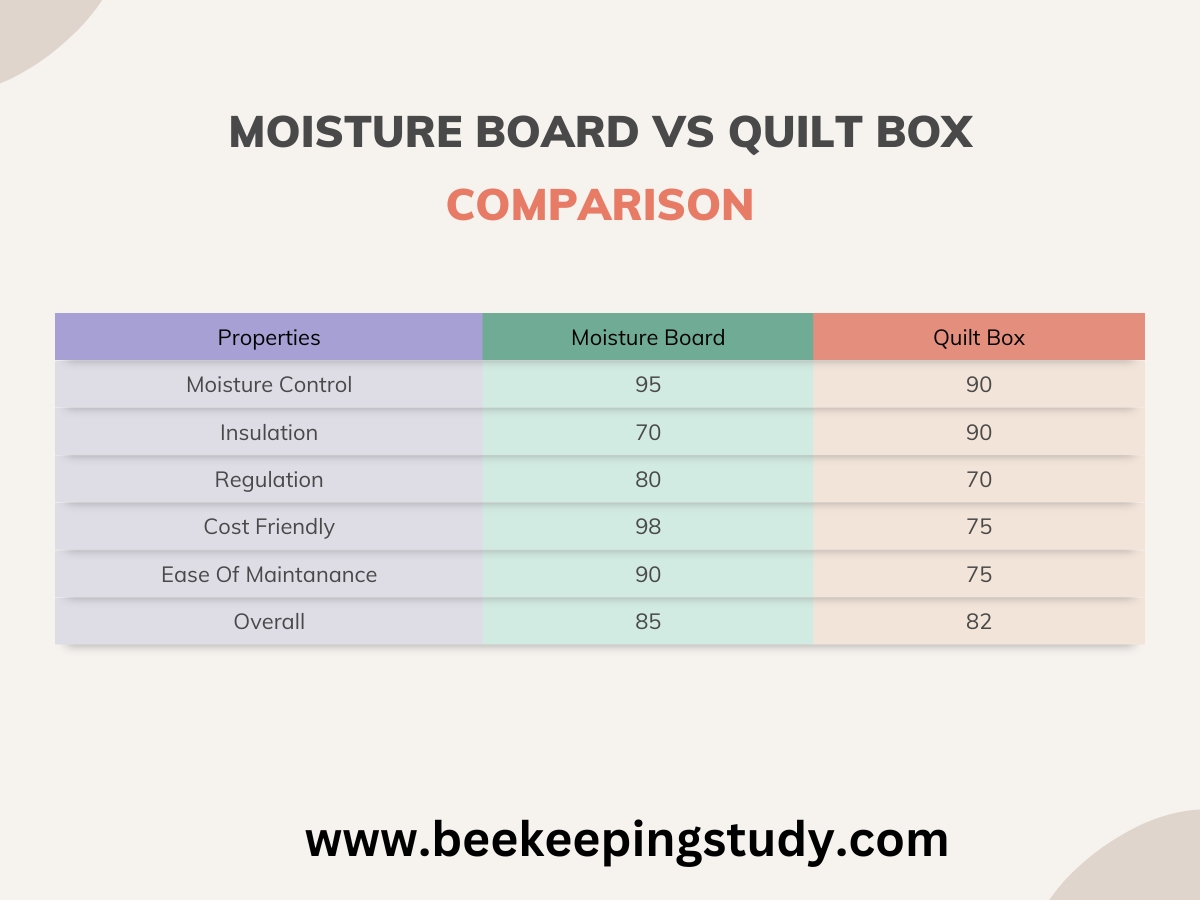
The following table gives the head-to-head special characteristics of the moisture board and quilt box.
| Properties | Moisture Board | Quilt Box |
| Moisture Control | Can contain a small amount of moisture for a long time. | Can hold large amounts of moisture for a shorter time than a moisture board. |
| Insulation | Comparatively poor insulation. | Ensures strong insulation. |
| Space | Requires very little space. | It requires large space consumption. |
| Cost | Comparatively less cost is required. | Comparatively expensive. |
| Inspection | Require less inspection. | Require frequent inspection. |
| Propolis build-up | Potential for bee propolis. | Reduced propolis build-up. |
Which One To Choose?
So far you have learned about both moisture board and quilt box. Both of them are excellent for protecting bees from cold during winter. Choosing one of them depends on various factors like climate, beehive dimension, personal preferences, etc.
Here are my tips that you can consider whether to choose a moisture board or quilt box for your beehive.
- Climate: If your region has very low temperatures during winter you can go with a quilt box. For regions where temperature is in a sustainable range, you can go with a moisture board. Also, a moisture board will be a better option for regions where moisture level fluctuates than a quilt box.
- Ventilation: If you are concerned with providing better ventilation besides moisture control, a moisture board will be a better choice for you.
- Insulation: If you want to lock the warmth produced by bees inside the hive, a quilt box will be a better option for you.
- Maintenance: If you don’t have enough time for frequent hive inspection, you can go with a moisture board.
In brief, if your region becomes very cold during winter you should go with a quilt box. Otherwise, you can go with any one of them.
Frequently Asked Questions
What is moisture board made of?
Moisture board is usually made with homasote board and plywood. It is filled with absorbent materials like wood chips or similar things.
What is the best humidity for a bee hive?
Beehives need a humidity level of 40% to 60%. Too low humidity causes dehydration for the bees. This leads bees to become aggressive and depressed. Higher humidity level causes excess moisture to build up inside the hive.
Where do you put a moisture board in a beehive?
A moisture board was placed at the top of the hive between the inner cover and the top cover. To use the moisture board effectively you can remove the inner cover. Because the moisture board can serve the purpose of inner cover too.
What happens if there is too much moisture in a bee hive?
Moisture of a certain level inside a beehive is common. However, too much moisture can lead to misery for the colony. Too much moisture makes the bees more prone to various diseases. Also, bees have to work very hard to control extra moisture inside the hive.
References & Helpful Articles
Following are the related works and some informative articles that might help you.
- J. P. Smith, “Title of the Paper,” Journal of Economic Entomology, vol. 42, no. 3, pp. 567, 1992. Read the paper here.
- A. A. Altun, “Remote Control of the Temperature-Humidity and Climate in the Beehives with Solar-Powered Thermoelectric System,” CEAI, vol. 14, no. 1, pp. 93-99, 2012. Read the paper here.
- J. P. Smith, “Self-Powered Smart Beehive Monitoring and Control System (SBMaCS),” Journal of Economic Entomology, vol. 42, no. 3, pp. 567, 1992. Read the paper here.
- Have you seen lots of dead bees on the ground? Here is why and what to do.
- Want to get rid of the dead bees smell? Check this.
- Learn the Advantages of a double brood box system.



